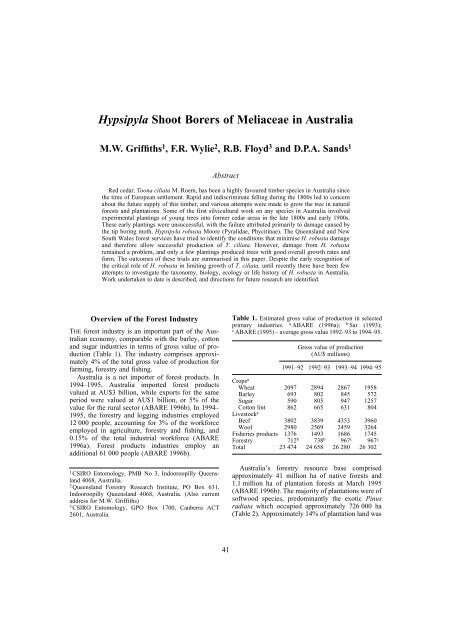Hypsipyla Shoot Borers of Meliaceae in Sri Lanka - Australian ...
Hypsipyla Shoot Borers of Meliaceae in Sri Lanka - Australian ...
Hypsipyla Shoot Borers of Meliaceae in Sri Lanka - Australian ...
You also want an ePaper? Increase the reach of your titles
YUMPU automatically turns print PDFs into web optimized ePapers that Google loves.
<strong>Hypsipyla</strong> <strong>Shoot</strong> <strong>Borers</strong> <strong>of</strong> <strong>Meliaceae</strong> <strong>in</strong> Australia<br />
M.W. Griffiths 1 , F.R. Wylie 2 , R.B. Floyd 3 and D.P.A. Sands 1<br />
Abstract<br />
Red cedar, Toona ciliata M. Roem, has been a highly favoured timber species <strong>in</strong> Australia s<strong>in</strong>ce<br />
the time <strong>of</strong> European settlement. Rapid and <strong>in</strong>discrim<strong>in</strong>ate fell<strong>in</strong>g dur<strong>in</strong>g the 1800s led to concern<br />
about the future supply <strong>of</strong> this timber, and various attempts were made to grow the tree <strong>in</strong> natural<br />
forests and plantations. Some <strong>of</strong> the first silvicultural work on any species <strong>in</strong> Australia <strong>in</strong>volved<br />
experimental plant<strong>in</strong>gs <strong>of</strong> young trees <strong>in</strong>to former cedar areas <strong>in</strong> the late 1800s and early 1900s.<br />
These early plant<strong>in</strong>gs were unsuccessful, with the failure attributed primarily to damage caused by<br />
the tip bor<strong>in</strong>g moth, <strong>Hypsipyla</strong> robusta Moore (Pyralidae, Phycit<strong>in</strong>ae). The Queensland and New<br />
South Wales forest services have tried to identify the conditions that m<strong>in</strong>imise H. robusta damage<br />
and therefore allow successful production <strong>of</strong> T. ciliata. However, damage from H. robusta<br />
rema<strong>in</strong>ed a problem, and only a few plant<strong>in</strong>gs produced trees with good overall growth rates and<br />
form. The outcomes <strong>of</strong> these trials are summarised <strong>in</strong> this paper. Despite the early recognition <strong>of</strong><br />
the critical role <strong>of</strong> H. robusta <strong>in</strong> limit<strong>in</strong>g growth <strong>of</strong> T. ciliata, until recently there have been few<br />
attempts to <strong>in</strong>vestigate the taxonomy, biology, ecology or life history <strong>of</strong> H. robusta <strong>in</strong> Australia.<br />
Work undertaken to date is described, and directions for future research are identified.<br />
Overview <strong>of</strong> the Forest Industry<br />
THE forest <strong>in</strong>dustry is an important part <strong>of</strong> the <strong>Australian</strong><br />
economy, comparable with the barley, cotton<br />
and sugar <strong>in</strong>dustries <strong>in</strong> terms <strong>of</strong> gross value <strong>of</strong> production<br />
(Table 1). The <strong>in</strong>dustry comprises approximately<br />
4% <strong>of</strong> the total gross value <strong>of</strong> production for<br />
farm<strong>in</strong>g, forestry and fish<strong>in</strong>g.<br />
Australia is a net importer <strong>of</strong> forest products. In<br />
1994–1995, Australia imported forest products<br />
valued at AU$3 billion, while exports for the same<br />
period were valued at AU$1 billion, or 5% <strong>of</strong> the<br />
value for the rural sector (ABARE 1996b). In 1994–<br />
1995, the forestry and logg<strong>in</strong>g <strong>in</strong>dustries employed<br />
12 000 people, account<strong>in</strong>g for 3% <strong>of</strong> the workforce<br />
employed <strong>in</strong> agriculture, forestry and fish<strong>in</strong>g, and<br />
0.15% <strong>of</strong> the total <strong>in</strong>dustrial workforce (ABARE<br />
1996a). Forest products <strong>in</strong>dustries employ an<br />
additional 61 000 people (ABARE 1996b).<br />
1 CSIRO Entomology, PMB No 3, Indooroopilly Queensland<br />
4068, Australia.<br />
2 Queensland Forestry Research Institute, PO Box 631,<br />
Indooroopilly Queensland 4068, Australia. (Also current<br />
address for M.W. Griffiths)<br />
3 CSIRO Entomology, GPO Box 1700, Canberra ACT<br />
2601, Australia.<br />
41<br />
Table 1. Estimated gross value <strong>of</strong> production <strong>in</strong> selected<br />
primary <strong>in</strong>dustries. a ABARE (1996a); b Sar (1993);<br />
c ABARE (1995) – average gross value 1992–93 to 1994–95.<br />
Gross value <strong>of</strong> production<br />
(AU$ millions)<br />
1991–92 1992–93 1993–94 1994–95<br />
Crops a<br />
Wheat 2097 2894 2867 1958<br />
Barley 693 802 845 572<br />
Sugar 590 805 947 1257<br />
Cotton l<strong>in</strong>t 862 665 631 804<br />
Livestock a<br />
Beef 3802 3839 4353 3960<br />
Wool 2980 2569 2459 3264<br />
Fisheries products 1376 1493 1686 1745<br />
Forestry 712 b 738 b 967 c 967 c<br />
Total 23 474 24 658 26 280 26 302<br />
Australia’s forestry resource base comprised<br />
approximately 41 million ha <strong>of</strong> native forests and<br />
1.1 million ha <strong>of</strong> plantation forests at March 1995<br />
(ABARE 1996b). The majority <strong>of</strong> plantations were <strong>of</strong><br />
s<strong>of</strong>twood species, predom<strong>in</strong>antly the exotic P<strong>in</strong>us<br />
radiata which occupied approximately 726 000 ha<br />
(Table 2). Approximately 14% <strong>of</strong> plantation land was

















